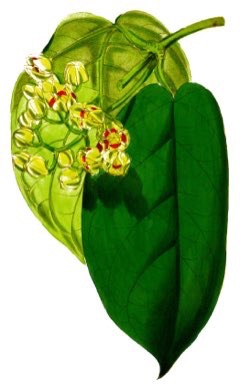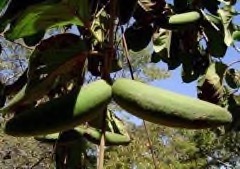 |
|
http://www.edibleplants.org |
 |
| Bart Wursten wikimedia.org |
Translate this page:
Summary
A vigorous, perennial, climbing shrub known as Mondia or White’s Ginger (Mondia whitei) is grown in tropical Africa for a wide range of uses including food, medicine, or fiber. It grows about 8 m long and has a large and tuberous rootstock. The leaves are large and opposite, characterized by purple lower-surface veins. The flowers are reddish-purple with a green edge and are short-lived. Edible parts are the leaves (fresh, dried, or cooked) and the fruits. The roots are used as food flavoring. Mondia is a valued medicinal plant especially for its roots. It is an aphrodisiac and also used against stomach pain, indigestion, constipation, and anorexia, and as appetite stimulant. Urinary infections, jaundice, cough, bronchitis, gonorrhea, and other conditions can also be treated using the roots. The stem yield fiber used to make ropes and a fine thread.
Physical Characteristics

 Mondia whitei is an evergreen Climber growing to 8 m (26ft) by 2 m (6ft) at a fast rate.
Mondia whitei is an evergreen Climber growing to 8 m (26ft) by 2 m (6ft) at a fast rate.
See above for USDA hardiness. It is hardy to UK zone 10. The flowers are pollinated by Flies.
Suitable for: light (sandy), medium (loamy) and heavy (clay) soils and prefers well-drained soil. Suitable pH: mildly acid, neutral and basic (mildly alkaline) soils. It can grow in semi-shade (light woodland) or no shade. It prefers moist soil.
UK Hardiness Map
US Hardiness Map
Synonyms
Plant Habitats
Edible Uses
Edible Parts: Fruit Leaves Root
Edible Uses: Condiment Drink Tea
The fresh or dried leaves are cooked, sometimes with peanut butter, and eaten as a vegetable[299 ]. The dried powdered leaves are added to food as a condiment[299 ]. The vanilla-like odour may have potential as a novel African fragrance or spice[299 ]. The fruits are considered edible in some parts of Africa, although in southern Africa the seeds are used as an arrow poison[299 ]. The roots are used to flavour food and tea[299 ]. They are also used to make an energizing drink for wedding parties and a ginger-like beer[299 ].
References More on Edible Uses
Medicinal Uses
Plants For A Future can not take any responsibility for any adverse effects from the use of plants. Always seek advice from a professional before using a plant medicinally.
Antidepressant Antiemetic Antiinflammatory Antitussive Aphrodisiac Appetizer Carminative Digestive
Diuretic Expectorant Laxative Malaria Parasiticide Purgative Restorative
Stomachic Tonic Urinary
The plant is widely used medicinally throughout its range, the root especially being valued. Relatively little research on the active compounds in the plant has been effected. The roots contain 1 - 1.2% of an essential oil, 2.8% of a fixed oil, 20% glucose, 0.7% resin and 0.045% of a glycoside[299 ]. The essential oil causes inflammation and reddening of the skin, irritation of the mucous membranes and relaxes mammalian intestinal smooth muscles[299 ]. Hexane, methanol and water extracts of the leaves and roots did not show any antibacterial activity against a range of human pathogens. The hexane and methanol extracts showed significant anti-inflammatory activity[299 ]. An aqueous root extract showed moderate activity against Schistosoma haematobium[299 ]. An aqueous root bark extract at 400 mg/kg/day given orally during 8 days increased testosterone production and fertility of male rats[299 ] An aqueous root extract administered to human spermatozoa in vitro was found to enhance total motility as well as progressive motility in a time-dependent manner[299 ]. Both the roots and the root bark have a pronounced vanilla-like odour and taste like a mixture of liquorice and ginger[299 ].They are anodyne, aphrodisiac, appetizer, carminative, diuretic, expectorant, purgative, restorative, stomachic, tonic and uterine stimulant[299 ]. The root is especially highly valued throughout Africa as an aphrodisiac - the fresh or dried roots are chewed to treat sexual weakness, prevent premature ejaculation and to increase sperm production[299 ]. A decoction or infusion is widely taken to treat digestive troubles including gastro-intestinal problems, stomach-ache, indigestion, constipation, anorexia, and as a restorative and appetite stimulant[299 ]. The decoction is also used to treat a wide range of other conditions, including urinary infections, gonorrhoea, jaundice, coughs, bronchitis, chest complaints, headache, paralysis and epileptic attacks, depression, to relieve body pains and to treat fits in children[299 ]. The root is pulverized and added to porridge in order to treat schistosomiasis[299 ]. A plant extract is taken to treat malaria[299 ]. The leaves are squeezed in water and the filtrate is drunk to stop heavy post partum bleeding[299 ].T A leaf decoction is drunk to stop vomiting[299 ].
References More on Medicinal Uses
The Bookshop: Edible Plant Books
Our Latest books on Perennial Plants For Food Forests and Permaculture Gardens in paperback or digital formats.

Edible Tropical Plants
Food Forest Plants for Hotter Conditions: 250+ Plants For Tropical Food Forests & Permaculture Gardens.
More

Edible Temperate Plants
Plants for Your Food Forest: 500 Plants for Temperate Food Forests & Permaculture Gardens.
More

More Books
PFAF have eight books available in paperback and digital formats. Browse the shop for more information.
Shop Now
Other Uses
Essential Fencing Fibre Parasiticide String Teeth
Agroforestry Uses: The plant is grown to reinforce enclosures[299 ]. Other Uses A fibre obtained from the stem yields a strong rope and a fine thread[299 ]. The woody parts of the root are used as chewing sticks[299 ].
Special Uses
Food Forest
References More on Other Uses
Cultivation details
The flowers have a slightly fruity, unpleasant odour, which becomes stronger in the afternoons. They remain open for between 3 and 4 days and are probably pollinated by flies[299 ]. Bloom Color: Red Cream/Tan. Spacing: 24-36 in. (60-90 cm).
References Carbon Farming Information and Carbon Sequestration Information
Temperature Converter
Type a value in the Celsius field to convert the value to Fahrenheit:
Fahrenheit:
The PFAF Bookshop
Plants For A Future have a number of books available in paperback and digital form. Book titles include Edible Plants, Edible Perennials, Edible Trees,Edible Shrubs, Woodland Gardening, and Temperate Food Forest Plants. Our new book is Food Forest Plants For Hotter Conditions (Tropical and Sub-Tropical).
Shop Now
Plant Propagation
Seed - Stem cuttings. Root cuttings.
Other Names
If available other names are mentioned here
Mondia, White's Ginger, Lacadje, Muombo, Nhavoma, Ogombo, Omurondwa, Pados, assase hwam, la racine, lufute lwa matwi, mbombongazi, tonicroot, umondi, white's ginger, white's-ginger, white’s ginger..
Native Range
AFRICA: Sudan (south), Kenya, Tanzania, Uganda, Burundi, Central African Republic, Cameroon, Democratic Republic of the Congo, Gabon, Côte D‘Ivoire, Ghana, Guinea, Guinea-Bissau, Liberia, Nigeria, Senegal, Sierra Leone, Angola, Mozambique, Malawi, Zambia, Zimbabwe, Namibia (northeast), Eswatini, South Africa (KwaZulu-Natal, Limpopo)
Weed Potential
Right plant wrong place. We are currently updating this section.
Please note that a plant may be invasive in one area but may not in your area so it's worth checking.
Conservation Status
IUCN Red List of Threatened Plants Status : This taxon has not yet been assessed

Growth: S = slow M = medium F = fast. Soil: L = light (sandy) M = medium H = heavy (clay). pH: A = acid N = neutral B = basic (alkaline). Shade: F = full shade S = semi-shade N = no shade. Moisture: D = dry M = Moist We = wet Wa = water.
Now available:
Food Forest Plants for Mediterranean Conditions
350+ Perennial Plants For Mediterranean and Drier Food Forests and Permaculture Gardens.
[Paperback and eBook]
This is the third in Plants For A Future's series of plant guides for food forests tailored to
specific climate zones. Following volumes on temperate and tropical ecosystems, this book focuses
on species suited to Mediterranean conditions—regions with hot, dry summers and cool, wet winters,
often facing the added challenge of climate change.
Read More
Expert comment
Author
(Hook.f.) Skeels
Botanical References
Links / References
For a list of references used on this page please go here
A special thanks to Ken Fern for some of the information used on this page.
Readers comment
| Add a comment |
|
If you have important information about this plant that may help other users please add a comment or link below. Only comments or links that are felt to be directly relevant to a plant will be included. If you think a comment/link or information contained on this page is inaccurate or misleading we would welcome your feedback at [email protected]. If you have questions about a plant please use the Forum on this website as we do not have the resources to answer questions ourselves.
* Please note: the comments by website users are not necessarily those held by PFAF and may give misleading or inaccurate information.
To leave a comment please Register or login here All comments need to be approved so will not appear immediately.
|
|